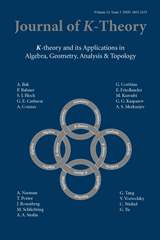Crossref Citations
This article has been cited by the following publications. This list is generated based on data provided by Crossref.
Szymik, Markus
2019.
The rational stable homology of mapping class groups of universal nil-manifolds.
Annales de l'Institut Fourier,
Vol. 69,
Issue. 2,
p.
783.
ZEMAN, TOMÁŠ
2021.
On the quotients of mapping class groups of surfaces by the Johnson subgroups.
Mathematical Proceedings of the Cambridge Philosophical Society,
Vol. 170,
Issue. 2,
p.
355.
BOHMANN, ANNA MARIE
and
SZYMIK, MARKUS
2023.
Boolean algebras, Morita invariance and the algebraic K-theory of Lawvere theories.
Mathematical Proceedings of the Cambridge Philosophical Society,
Vol. 175,
Issue. 2,
p.
253.
Bohmann, Anna Marie
and
Szymik, Markus
2024.
GENERALISATIONS OF LODAY’S ASSEMBLY MAPS FOR LAWVERE’S ALGEBRAIC THEORIES.
Journal of the Institute of Mathematics of Jussieu,
Vol. 23,
Issue. 2,
p.
811.

